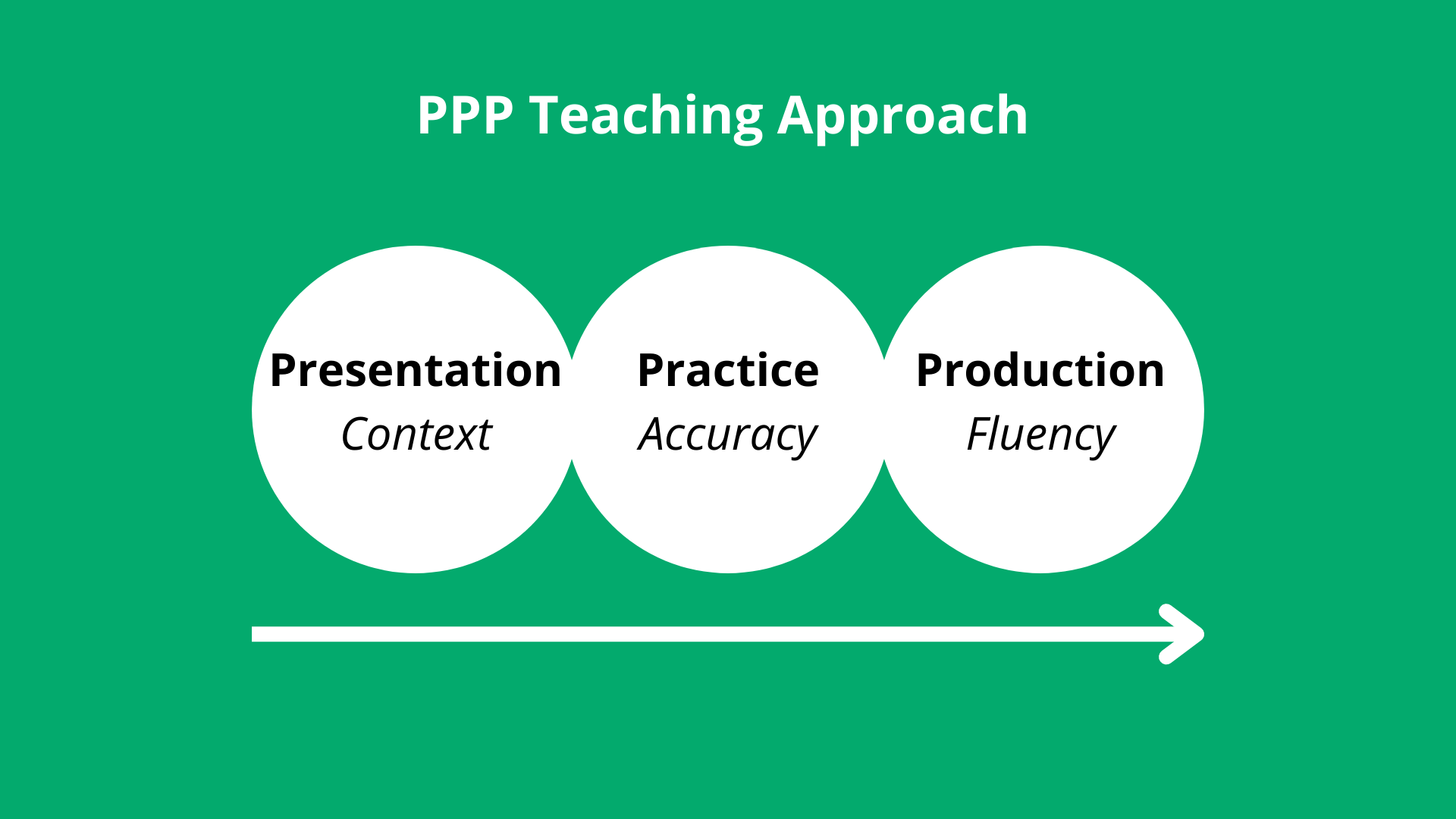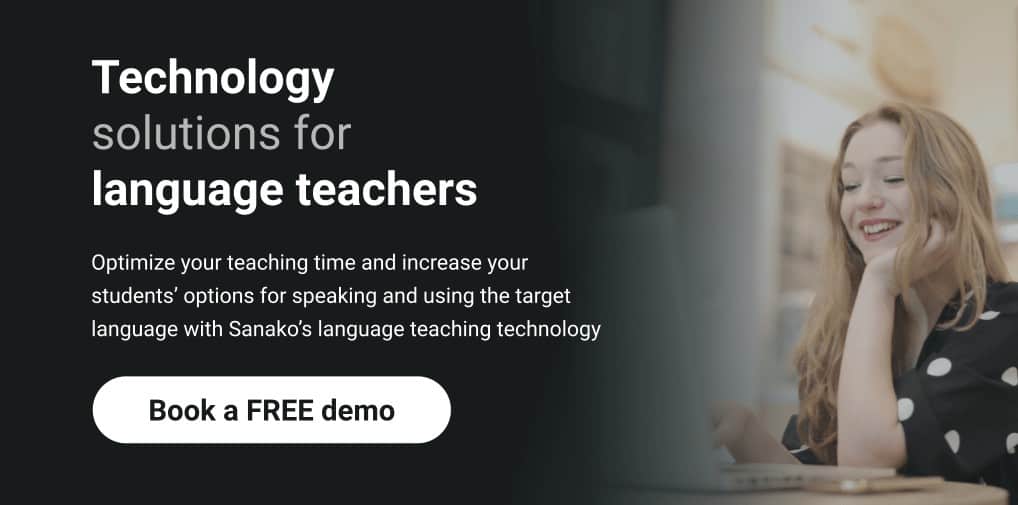Understanding the grammatical elements and key vocabulary of a language are essential parts of achieving a good degree of fluency. Without them, it is pretty difficult to communicate clearly with a native language speaker. Grammar and vocabulary can therefore be seen as structural parts of a language and usually require a specific teaching methodology to deliver effectively.
Deductive approaches to teaching grammar and vocabulary are commonly used in this regard and form part of initial teacher training courses like the CELTA and CertTESOL. In such approaches a teacher presents a rule / structure to the class and the class then produces language based on that rule. This technique easily fits into a lesson structure known as PPP (Presentation, Practice and Production). This blog post explores the PPP language lesson plan structure in detail, outlining how and where it can be most effectively used in English language and foreign language teaching classrooms.
The PPP lesson structure

As outlined in the image above, the PPP model consists of three progressive stages, which combine to engage and motivate language learners. Best practice suggests that a 60-minute lesson should feature equal time (i.e 20 minutes) to each stage – language teachers can therefore plan out their lessons in advance allowing enough time to address any issues that students may encounter. It is worth noting that this structure therefore works best with classes of uniform ability – otherwise less able students can be left behind if the key learning outcomes have not been fully understood. (Remember to check out our other post for ideas on how to tailor lessons based on students’ different language levels).
Let’s work through each of the PPP stages in turn.
1. The ‘Presentation’ Stage
In this stage the teacher presents the new grammar concept or vocabulary in a meaningful context or situation to their learners. Building up stories on the board, using realia (e.g newspaper cuttings, household items, hobby materials), flashcards and miming are fun ways to present the language. Short audio or film clips can also be highly effective.
The aim of this stage is to ensure that the students understand the context you are presenting and to get them to start thinking about it. Always try to get their thoughts on the context you’ve presented – ask them if they have been in this situation, has a family member? How did it make them feel and what happened next? This helps students to bring the situation to life and helps them remember previous scaffolding on the topic (i.e grammar and vocab that they already know).
2. The ‘Practice’ Stage
In this stage, students begin to use the elements of the target language that they learnt previously through activities developed by the educator. The stage is usually controlled by the teacher and learners practice saying or writing the language structure or vocabulary correctly. Teachers should certainly model and correct if mistakes occur.
Typical practice stage activities include:
- Drill sentences / sounds – individually, in pairs or whole class
- Multiple-choice exercises
- Gap fill tasks
- Directed, paired conversation practice
The aim of these practice activities is building students’ accurate use of target language. If common errors persistently occur, then a specific exercise or recap session might be useful.
3. The ‘Production’ Stage
Once learners have demonstrated that they fully understand the key learning points and are able to demonstrate this without mistakes in controlled exercises, they can move onto the (free) production stage. In this stage, students are encouraged to use the target language as fluently and naturally as possible to replicate use outside of the language classroom.
Typical production stage activities include
- Role-plays
- Communication tasks (e.g presentations, speeches, debates, articles)
- Collaborative tasks
- Discussion activities
In this stage the teacher should not intervene or correct whilst students are “producing” language. Rather if mistakes have been made, it is better to address them after the exercise has been completed.
Advantages and disadvantages of the PPP lessons in language teaching
As with all language teaching strategies and lesson structures, the PPP approach is not 100% guaranteed to work brilliantly in all classrooms and with all students. A review of the literature relating to the PPP approach identifies a number of advantages and disadvantages which we summarise below.
Advantages
- The PPP method is easy to adopt and is good for new language teachers
- The approach is widely applicable and can be used very flexibly
- It’s easy to plan a lesson around and has a clear, logical structure for students (and educators) to follow
- Evidence suggests that teachers trained on this method are more likely to use new teaching methods than those who do not.
Disadvantages
- It encourages and prioritises accuracy over fluency
- The presentation stage is too teacher-focused and has limited student engagement
- It can become boring to students if used repeatedly, particularly for higher language proficiency students
- Research suggests that it might not be the most effective way to teach or learn a language
As always, our recommendation would be to test it and try it in your setting and then tailor it to your specific circumstances. Maybe see how some form of learner-focused guided discovery could be incorporated into the presentation stage. Collaborative learning activities could, for example, also be included in the practice stage and a task, such as you might find in a task based learning approach would also fit well into the final stage.
How do Sanako products help educators to teach using the PPP lesson plan?
Sanako produces a range of language learning and teaching tools that help educators to improve their students’ reading skills. For example our browser-based language teaching solution Sanako Connect supports educators across all stages of the PPP language teaching approach.
- PRESENTATION – Educators can create distinctive contexts and situations in Sanako Connect using a wide variety of easily uploadable stimulus materials including text files, PDFs, presentations, audio clips, video, and web pages.
- PRACTICE – Test students’ understanding of grammar concepts and key vocabulary by creating exercises and questions for them to answer through gap-fill and multiple-choice quizzes.
- PRODUCE – Students can be easily divided into pairs or group discussions and be assigned role play and discussion activities. Outputs and deliverables can be collected, and reviewed on the same platform.
If you’d like to find out more about how Sanako’s dedicated language teaching solutions could transform your approach to teaching English or other modern languages, please contact us now to arrange your FREE demo!
This blog post was last updated 26 September, 2023.

